Have you ever fancied achieving a blissful state of altered consciousness without having to rely on a trip of the chemical kind? Do you want to expand the capacity of your mind? Learn without effort? Reduce your inhibitions and improve your memory? Did you know that you can reach this altered state of consciousness and achieve all this by simply lying down for 20 mins?
The best sleep you will ever get
The literal translation of Yoga nidra is ‘yogic sleep’. Yoga Nidra is an ancient tantric method which can open new capacities of mind. It was brought to the West by the Indian guru, Swami Satyananda Saraswati, in the 60s. We are not talking about any other practice that may be called the same thing. When I refer to yoga nidra in this article and in my practice I am talking about the systematic practice developed in the Bihar school of India.
This system of yoga nidra relates to a deep sleep state where the mind is deeply relaxed but with a wide open awareness and it is one of the deepest of all meditations, and brings an incredible calmness, quietness and clarity.
Supreme stillness
Yoga Nidra is a practice which leads awareness through many levels of mental process to a state of supreme stillness, receptivity and insight. Like all yoga practices it is the persistent practise that brings about real transformation and joy. It can be considered a form of meditation. However, in meditation you remain in the waking state of consciousness and gently focus the mind whilst allowing thought patterns, emotions and sensations to come and go. In comparison, in Yoga Nidra you leave the waking state, go beyond the dreaming state into a state similar to deep sleep, whilst remaining awake. It is a very powerful state for your brain to be in!
Yoga nidra is typically led by a qualified and trained teacher and lasts 15 mins to half an hour. You lie on the floor your back or, for some practices, sit in a meditation posture. And mentally follow the instructions that you teacher talks you through.
Changing brain waves
The practice induces brain waves that are predominantly delta (0.5 to 3.5 cycles per sec): the state of deep stillness and profound openess. When you first try yoga nidra you will experience the profound relaxation that the practice brings about. And you will almost certainly fall asleep! In fact, if you suffer from disturbed sleep patterns yoga nidra is a great way to balance and restore sleep patterns. However, at some point your practice will deepen and you will experience a moment, like a flash, where you experience the breath-taking depths of yoga nidra.
As in many yoga practices, you need to be patient. There is no right or wrong. If you fall asleep that is fine: and probably what you need at that time! Whilst this is not the ultimate state that yoga nidra aims for, it is certainly of benefit to mental and physical health and encourages the brain to slow down from its active aroused beta state (14 to 30 cycles per sec) to a calmer alpha wave range (8 to 13 cps).
The stages of yoga nidra
The methods that take you up the ultimate yoga nidra state are, in themselves, very relaxing and help to train the mind. The key stages of this technique are:
- progressive relaxation
- body awareness
- rotation of consciousness
- summoning of emotions and states
- control of physical states
- visualisation
- chakra work
- breath awareness
- sankalpas (affirmations) – a powerful method of reshaping your personality and experience of the world for the better
The term ‘yoga nidra’ actually refers to the state of consciousness that is achieved in the ultimate practice of the technique but it is often used erroneously to refer to the various methods listed above. It is the end state not the method that is eponymous.
Benefits of yoga nidra
The overall benefits of yoga nidra include:
- total relaxation of all systems of the body
- nervous and hormonal system efficiency
- enhanced health
- the ultimate way to de-stress (yoga nidra is HUGELY beneficial for the alleviation of stress)
- elminate insomnia
- mental and emotional relaxation
Yoga nidra in education
Educational innovators such as Dr Georgi Lozanov, a Bulgarian psychologist and the founder-director of the Institute of Suggestopedy in Sofia, are now utilizing yoga nidra to create an atmosphere in which knowledge is gained without effort. Dr Georgi Lozanov, recognizing that the state of active and relaxed awareness in students awakens the desire to learn, improves memory and reduces inhibition, has devised methods for teaching/learning of foreign languages that are three to five times faster, with the use of relaxation and music. As the class proceeds, the students effortlessly assimilate an enormous amount of knowledge, which, under conventional classroom conditions, would surely precipitate strain, tiredness and loss of concentration.
Yoga nidra is being tapped internationally as a means of improving conscious recall thereby increasing memory function. Yoga nidra is a promising technique that will revolutionize the teaching procedures in the future by enabling students to assimilate knowledge without much effort. There are students who want to learn, but their conscious mind is weak or unreceptive. Such children with learning disabilities can benefit from yoga nidra by absorbing knowledge through the subconscious mind. Such children can be taught by transmitting symbolic forms directly into his subconscious.
Reducing illness
Yoga Nidra has also been scientifically proven to reduce the ‘psychosomatic’ illnesses caused by the general under currents of tension that we live with:
- diabetes
- migraines
- asthma
- ulcers
- digestive problems
Yoga nidra will help you reach a deep state of releasing, relaxing and letting go: but really its bigger benefit is an emptying of oneself into wonder.
Sue Tupling of Embodied Living is qualified to teach and practice yoga nidra.

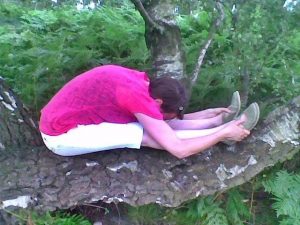
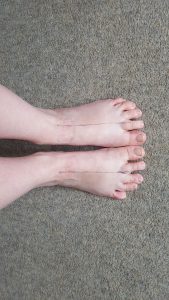 Our bodies and our minds are intimately connected and how we use our bodies has an impact – positive or negative – on our mind. If we are suffering from anxiety, depression or symptoms of trauma such as numbness or dissociation, practising standing postures can help to ground us and bring us into our bodies in a way that is beneficial to the mind.
Our bodies and our minds are intimately connected and how we use our bodies has an impact – positive or negative – on our mind. If we are suffering from anxiety, depression or symptoms of trauma such as numbness or dissociation, practising standing postures can help to ground us and bring us into our bodies in a way that is beneficial to the mind.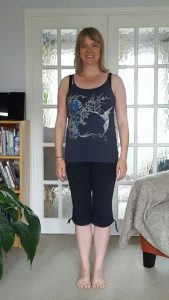 In order to stand in this ‘feet together’ position, I focus on pushing into the balls of my big toes, the shins rotate radially outwards a little and the inner thighs draw upwards and inwards (medial rotation). This pushes the seat bones out and gives space in the sacral joint, back of the hips and keeps the pelvis upright and neutral (which lengthens the psoas muscle) and thus honours the natural curvature of the spine. There seems to be more containment and control of energy – perhaps this is because the muscles used to hold this posture activate the bandhas (root locks) particularly mula bandha. This feels like l have more control over my energy, I feel calmer and more centred and in control.
In order to stand in this ‘feet together’ position, I focus on pushing into the balls of my big toes, the shins rotate radially outwards a little and the inner thighs draw upwards and inwards (medial rotation). This pushes the seat bones out and gives space in the sacral joint, back of the hips and keeps the pelvis upright and neutral (which lengthens the psoas muscle) and thus honours the natural curvature of the spine. There seems to be more containment and control of energy – perhaps this is because the muscles used to hold this posture activate the bandhas (root locks) particularly mula bandha. This feels like l have more control over my energy, I feel calmer and more centred and in control.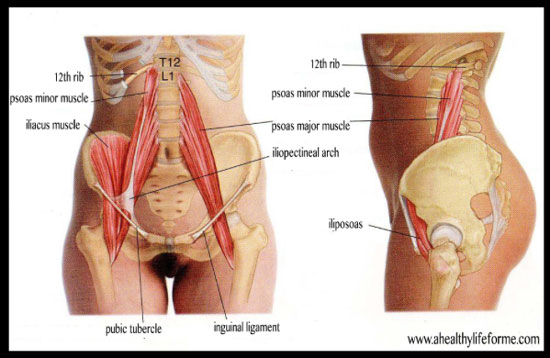
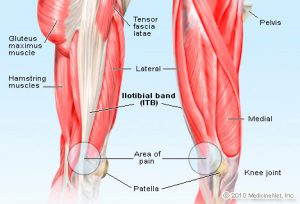 Tightness in this muscle is an underlying cause of back injury. The iliotibial band (IT) is a band of fascia that runs down the outside of the legs from the hips to the top of the shins. Remember, fascia is ‘plastic’ and not elastic like muscle, so is hard to change it. The tensor fascia latta (TFL) is the muscle that runs into this band, and this whole structure is often tight, which also causes very tight gluteal muscles. A tight TFL and IT band will pull the knees to the outside of the hips and put undue pressure on the sacrum. It will result in knee, back and sacroiliac problems. Therefore the TFL and IT band need to be stretched and lengthened over time. In my experience, these are some of the most important muscles to befriend in working successfully to access the many benefits of the ‘feet together’ position in yoga. We need to lengthen the hamstrings, the psoas and the often overlooked deep hip flexors as well as the TFL in order to safely work in strong yoga postures from the feet parallel position and also to avoid getting injuries.
Tightness in this muscle is an underlying cause of back injury. The iliotibial band (IT) is a band of fascia that runs down the outside of the legs from the hips to the top of the shins. Remember, fascia is ‘plastic’ and not elastic like muscle, so is hard to change it. The tensor fascia latta (TFL) is the muscle that runs into this band, and this whole structure is often tight, which also causes very tight gluteal muscles. A tight TFL and IT band will pull the knees to the outside of the hips and put undue pressure on the sacrum. It will result in knee, back and sacroiliac problems. Therefore the TFL and IT band need to be stretched and lengthened over time. In my experience, these are some of the most important muscles to befriend in working successfully to access the many benefits of the ‘feet together’ position in yoga. We need to lengthen the hamstrings, the psoas and the often overlooked deep hip flexors as well as the TFL in order to safely work in strong yoga postures from the feet parallel position and also to avoid getting injuries.